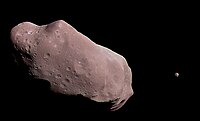
Photo from wikipedia
Tidal dissipation plays an important role in the dynamical evolution of moons, planets, stars and compact remnants. The interesting complexity originates from the interplay between the internal structure and external… Click to show full abstract
Tidal dissipation plays an important role in the dynamical evolution of moons, planets, stars and compact remnants. The interesting complexity originates from the interplay between the internal structure and external tidal forcing. Recent and upcoming observing missions of exoplanets and stars in the Galaxy help to provide constraints on the physics of tidal dissipation. It is timely to develop new N-body codes, which allow for experimentation with various tidal models and numerical implementations. We present the open-source N-body code TIDYMESS, which stands for ‘TIdal DYnamics of Multi-body ExtraSolar Systems’. This code implements a Creep deformation law for the bodies, parametrized by their fluid Love numbers and fluid relaxation times. Due to tidal and centrifugal deformations, we approximate the general shape of a body to be an ellipsoid. We calculate the associated gravitational field to quadruple order, from which we derive the gravitational accelerations and torques. The equations of motion for the orbits, spins and deformations are integrated directly using a fourth-order integration method based on a symplectic composition. We implement a novel integration method for the deformations, which allows for a time step solely dependent on the orbits, and not on the spin periods or fluid relaxation times. This feature greatly speeds up the calculations, while also improving the consistency when comparing different tidal regimes. We demonstrate the capabilities and performance of TIDYMESS, particularly in the niche regime of parameter space where orbits are chaotic and tides become non-linear.
Journal Title: Monthly Notices of the Royal Astronomical Society
Year Published: 2022
Link to full text (if available)
Share on Social Media: Sign Up to like & get
recommendations!